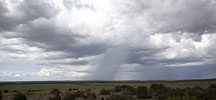- Number 365 |
- June 18, 2012
Desert dust intensifies summer rainfall in U.S. southwest

Scientists have found that desert dust
increases the monsoon effect in the
United States.
Photo from Wikimedia Commons.
Dust kicked up from the desert floor acts like a heat pump in the atmosphere, fueling the annual climate system called the North American Monsoon, according to scientists at DOE’s Pacific Northwest National Laboratory. The dust increases precipitation by up to 40 percent during the summer rainy season in Arizona, New Mexico and Texas. Their study, the first on the U.S. Southwest summer monsoon, found that the heat pump effect, attracting moisture from nearby oceans and increasing seasonal rainfall, is consistent with how dust acts on West African and Asian monsoon regions.
As the climate warms, more regions of the world will be affected by drought. Increased desert regions and dry land produce more dust that gets lofted into the atmosphere. These dust particles absorb sunlight and act as a heat pump. PNNL researchers are the first to investigate this effect in an area of the United States where water resources are limited. Understanding how dust contributes to atmospheric heating is important for predicting drought and rainfall patterns in this region and others in the world with rising populations.
This research was supported by DOE's Investigation of the Magnitudes and Probabilities of Abrupt Climate TransitionS (IMPACTS) project. The research used computing resources from the National Energy Research Scientific Computing Center, supported by DOE’s Office of Science.
[Kristin Manke, 509.372.6011,
Kristin.manke@pnnl.gov]
